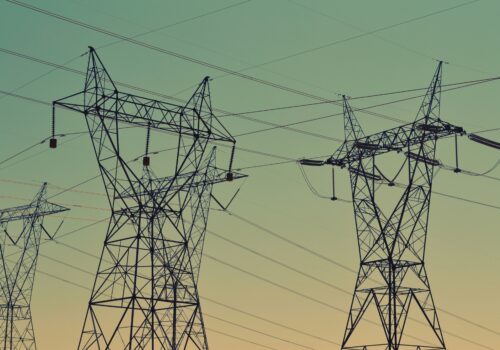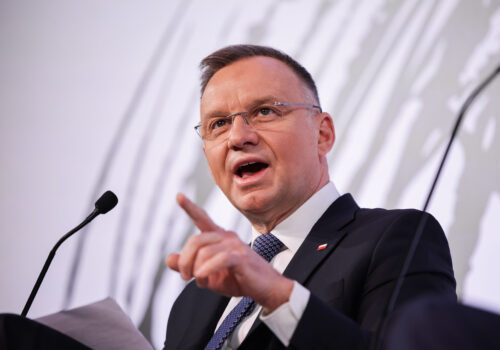Leaders at the ninth Three Seas Summit and Business Forum, held in Vilnius in April, raised the need for creating a permanent body that would institutionalize regional cooperation on digital, transport, and energy integration. While there is little disagreement among participating countries that such an office is needed, their views diverge on the location of this coordinating body, reporting structure, and coverage of its operating costs.
Solving these administrative problems is one of the biggest impediments to formalizing a secretariat. To ensure that the Three Seas Initiative (3SI), which convenes at the annual summits, can effectively and quickly address the unique challenges facing its thirteen Southeastern, Central, and Eastern European member states, associate states, and strategic partners in reaching common goals, its leaders must now agree on a structure.
STAY CONNECTED
Sign up for PowerPlay, the Atlantic Council’s bimonthly newsletter keeping you up to date on all facets of the energy transition.
More than 900 participants joined this year’s summit, which every year aims to explore ways to tap members’ vast economic potential while fortifying against mounting security threats. They discussed ways to advance connectivity, economic growth, and broader security by overcoming shared regional barriers via the 3SI mechanism. However, making progress between summits requires institutionalization of the 3SI through a permanent secretariat body to maintain momentum and focus between the annual events.
How a 3SI institution could work
The secretariat could be launched and housed in a neutral, non-3SI city in Europe, preferably a financial hub, like Brussels, with a small permanent team whose operating costs would be covered by the 3SI country hosting the summit that year. The 3SI team’s initial guidance could include exchange of information between 3SI stakeholders, outreach to private investors, and the promotion of cross-border digital, energy, and transportation projects in the region, with a particular focus on the project priority list. In a sense, the secretariat would serve as a library of projects for inquiring investors. The 3SI platform can play a meaningful role in helping resolve top priority issues in the region, which were raised repeatedly at the summit, ministerial, and in private events (including those jointly hosted by the Atlantic Council, Clean Air Task Force, and Amber Infrastructure Group). These issues include:
- Access to finance
- Fragmented market
- Supply chains risks
- Russian aggression in Ukraine and the broader region
- Commercialization of new technologies and innovative solutions
- Workforce shortages
By addressing these challenges throughout the year (through the work between the summits), the 3SI stakeholders would create compounding benefits, securities, and efficiencies for Europe, particularly through 3SI’s unique power to connect traditionally siloed sectors and geographies and its magnifying platform for bringing attention to the top challenges in the region.
Leaning into the 3SI mission
Once a 3SI body is created, it can rapidly get to work on actualizing steps toward achieving its goals, including regional integration of resources, coordination of workforce development, optimization of external partnerships, and raising finance. Dialogue at the Three Seas summits has yielded broad consensus and support for these priorities.
Goal 1: Integrating the regions, markets, and innovation
Despite gigantic leaps in connectivity across Europe, regional integration is hampered by the lack of cross-border coordination, regulatory hurdles, supply chain risks, and market fragmentation. These gaps create diverging prices, inefficient routes, and lags in information sharing. 3SI would not be a one-fix-fits-all in resolving these issues, but the presidential-level platform has untapped potential to alleviate some of these challenges. 3SI is uniquely positioned to highlight the regional cost and security threats of insufficient energy interconnection, transportation routes, and digital integration. Priority-project lists should be frequently updated and expanded, something the secretariat can manage, to provide ample options for potential investors with projects’ bankability and other relevant details included.
Moreover, 3SI has a unique opportunity to embrace a technologically neutral approach while focusing on solutions-driven criteria: competitive pricing, carbon emissions, environmental impacts, and secure and diversified supply chains. To scale new technologies, the 3SI secretariat could support existing regional coordination on regulatory alignment to forge an easy-to-navigate investment environment. Cooperation on cyber security and kinetic threats across 3SI stakeholders can enhance protection for these technologies and infrastructure in the region.
Goal 2: Investing in a workforce that will transform the region
In addition to the work dismantling regulatory barriers, 3SI can contribute to forging an innovation ecosystem through building a talented workforce for the future. The Three Seas economies have a unique opportunity to exchange data around the current labor force and the anticipated talent gap in energy, digital, and transportation sectors. The region is already leading in science and technology education in Europe and can build on this competitive advantage by scaling the number of trained professionals through coordinating programs and forging an efficient education-to-workforce placement pipeline. The annual 3SI summits could include programming dedicated to student engagement, recruitment, and education on key opportunities in the growing sectors.
Goal 3: Optimizing collaboration with 3SI associated and strategic partners
Japan’s inclusion as a 3SI strategic partner this year is a testament to the value of global partnership on commercialization of new technologies and diversified supply chains. Several summit panels touched on driving Japanese companies’ investments in the region, particularly rail and communications sectors development.
3SI countries also have an opportunity to develop strategic priorities in support of associate members Ukraine and Moldova (complementary to the existing efforts), while exploring the potential to build additional energy and transport interconnections, as well as collaboration in the digital space.
Goal 4: Financing a secure, competitive, and low-carbon Three Seas region
An enormous barrier to achieving 3SI priorities is the trillion-dollar gap between where infrastructure stands today and where the region agrees it needs to be. National budgets are insufficient. EU funding is challenging to access and excludes some infrastructure and technologies. The Three Seas Fund, 3SI’s investment arm, can play an important role in leveraging private finance and helping match public and private capital to realize the projects. As the next round of the 3SI fund is established, attracting private equity will be crucial for reaching scale of impact. Cross-country coordination creates efficiency and minimizes risk for cross-border investments, particularly in addressing the grid infrastructure gaps and preparing roads for a safe, low-carbon transportation future.
Achieving a shared vision of the future
No similar coalition exists with focus on security and economic prosperity through integration. This shared vision of a secure, digitized, integrated, low-carbon, resilient economy is refined every year at the Three Seas Summit as new ideas are shared on stage, discussed during coffee breaks, and put to the test following the conference. With the formalization of a 3SI institution to build on the work between summits, 3SI could be an unstoppable platform for realizing the region’s rich potential and talent.
Olga Khakova is the deputy director for European energy security at the Atlantic Council Global Energy Center
MEET THE AUTHOR
RELATED CONTENT
OUR WORK

The Global Energy Center develops and promotes pragmatic and nonpartisan policy solutions designed to advance global energy security, enhance economic opportunity, and accelerate pathways to net-zero emissions.





